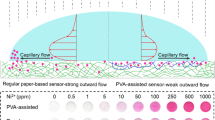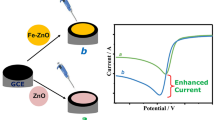Abstract
Given the effects of metal ions on environment and human’s health, it is very important to identify them in aqueous solutions. Core–shell structures can be used to identify metal ions through preparation of paper sensors. In the present research, ZnO@ZnS nanoparticles with core–shell structure were prepared through two-step low temperature green synthesis process using aloe vera and lettuce extracts. The synthesized nanoparticles were characterized by Fourier transform infrared, X-ray diffraction, scanning electron microscopy, and transmission electron microscopy analyses. The results of FTIR and XRD analyses confirmed successful formation of ZnO@ZnS core–shell structures. Micrographs of the synthesized particles also showed flaky shapes with sharp edges and random orientations. Size range of core–shell nanoparticles varied between 20 and 70 nm. Then, the solution containing green synthesized ZnO@ZnS nanoparticles was distributed onto the papers and after drying at room temperature was used as paper sensors to identify Pb2+ and Fe2+ ions. The color intensity of the sensors changed due to contact with solutions containing different concentrations of Pb2+ and Fe2+ ions (75–1500 μM). In addition, increasing concentration of ions increased color intensity of sensors and the relationship between color intensity and ion concentration was expressed by related equations. Therefore, it was possible to determine the concentration of lead and iron ions according to the color intensity. Comparison between the performance of the sensors exposed to the solutions prepared from deionized water and ZayandehRud River water showed an acceptable error of up to 5%. The results of XRD analysis on paper sensors after contacting with Pb2+ and Fe2+ ions confirmed the formation of PbS and FeS.











Similar content being viewed by others
Availability of data and materials
Available from the corresponding author on reasonable request.
References
Abbaspour N, Hurrell R, Kelishadi R (2014) Review on iron and its importance for human health. J Res Med Sci 19:164–174
Bishop JA (1954) The solubility product: a proportionality constant. J Chem Educ 31:574
Boczkaj G, Fernandes A (2017) Wastewater treatment by means of advanced oxidation processes at basic pH conditions: a review. Chem Eng J 320:608–633
Chang CJ, Chen JK, Lin KS et al (2021) Improved H2 production of ZnO@ZnS nanorod-decorated Ni foam immobilized photocatalysts. Int J Hydrog Energy 46:11357–11368. https://doi.org/10.1016/j.ijhydene.2020.06.192
Cheon SY, Yoon J, Oh KH et al (2017) Sonochemical synthesis of ZnO-ZnS core-shell nanorods for enhanced photoelectrochemical water oxidation. J Am Ceram Soc 100:3825–3834
Ciğeroğlu Z (2021) Preparation of ZnO/BaTiO3 adsorbent using Elaeagnus Angustifolia L. leaf extract and its evaluation for ciprofloxacin removal from aqueous solutions: an optimization study. Biomass Convers Biorefinery 11:1407–1417. https://doi.org/10.1007/s13399-021-01593-9
Curry SJ, Krist AH, Owens DK et al (2019) Screening for elevated blood lead levels in children and pregnant women: US preventive services task force recommendation statement. JAMA J Am Med Assoc 321:1502–1509. https://doi.org/10.1001/jama.2019.3326
De Quadros Melo D, De Oliveira Sousa Neto V, De Freitas Barros FC et al (2016) Chemical modifications of lignocellulosic materials and their application for removal of cations and anions from aqueous solutions. J Appl Polym Sci 133:1–22. https://doi.org/10.1002/app.43286
Dong B, Cao L, Su G et al (2009) Synthesis and characterization of the water-soluble silica-coated ZnS: Mn nanoparticles as fluorescent sensor for Cu2+ ions. J Colloid Interface Sci 339:78–82
Engwa GA, Ferdinand PU, Nwalo FN, Unachukwu MN (2019) Mechanism and health effects of heavy metal toxicity in humans. In: Karcioglu O, Arsalan B (eds) Poisoning in the modern world. IntechOpen, pp 77–99
Goudarzi H, Seidali Lir Z (2019) Fabrication of core–shell ZnO/ZnS nanorods by hydrothermal method and study of their structural and optical properties. J Res Many-Body Syst 8:171–181
Goutam SP, Saxena G, Roy D, et al (2020) Green synthesis of nanoparticles and their applications in water and wastewater treatment. In: Saxena G, Bharagava RN (eds) Bioremediation of industrial waste for environmental safety. Springer, Singapore, pp 349–379. https://doi.org/10.1007/978-981-13-1891-7_16
Guha S, Roy S, Banerjee A (2011) Fluorescent Au@ Ag core–shell nanoparticles with controlled shell thickness and HgII sensing. Langmuir 27:13198–13205
Hitkari G, Singh S, Pandey G (2017) Structural, optical and photocatalytic study of ZnO and ZnO–ZnS synthesized by chemical method. Nano-Struct Nano-Objects 12:1–9. https://doi.org/10.1016/j.nanoso.2017.08.007
Keogh W, Boakye GO, Neville A, et al (2018) Lead sulfide (PbS) scale behavior and deposition as a function of polymeric sulfide inhibitor concentration in multiphase. In: NACE 2018: proceedings of the international corrosion conference and expo series, OnePetro, Phoenix, Arizona, USA
Khatami M, Alijani HQ, Sharifi I (2018) Biosynthesis of bimetallic and core–shell nanoparticles: their biomedical applications—a review. IET Nanobiotechnol 12:879–887. https://doi.org/10.1049/iet-nbt.2017.0308
Li M, Liu J, Xu Y, Qian G (2016) Phosphate adsorption on metal oxides and metal hydroxides: a comparative review. Environ Rev 24:319–332
Li Y, Shan L-X, Lian X-X et al (2021a) Enhanced NO2 sensing performance of ZnO@ZnS core–shell structure fabricated using a solution chemical method. Ceram Int 47:27411–27419. https://doi.org/10.1016/j.ceramint.2021.06.163
Li Y, Song S, Zhang L-B et al (2021b) Fabrication of hollow porous ZnO@ZnS heterostructures via hydrothermal method and enhanced gas-sensing performance for ethanol. J Alloys Compd 855:157430–157437. https://doi.org/10.1016/j.jallcom.2020.157430
Mahmoud WE (2017) Synthesis and characterization of 2A–3SHPA decorated ZnS@ CdS core–shell heterostructure nanowires as a fluorescence probe for antimony ions detection. Sens Actuat B Chem 238:1001–1007
Makarov VV, Love AJ, Sinitsyna OV et al (2014) “Green” nanotechnologies: synthesis of metal nanoparticles using plants. Acta Naturae (aнглoязычнaя вepcия) 6:35–44
Michałowska-Kaczmarczyk AM, Spórna-Kucab A, Michałowski T (2017) Solubility products and solubility concepts. In: Akitsu T (ed) Descriptive inorganic chemistry researches of metals compounents, InTech, Croatia, pp 93–134. https://doi.org/10.5772/67840
Pan Y, Hong G, Raja SN et al (2015) Significant thermal conductivity reduction of silicon nanowire forests through discrete surface doping of germanium. Appl Phys Lett 106:1–6. https://doi.org/10.1063/1.4913879
Rocha A, Trujillo KA (2019) Neurotoxicity of low-level lead exposure: history, mechanisms of action, and behavioral effects in humans and preclinical models. Neurotoxicology 73:58–80. https://doi.org/10.1016/j.neuro.2019.02.021
Sadollahkhani A, Hatamie A, Nur O et al (2014a) Colorimetric disposable paper coated with ZnO@ZnS core–shell nanoparticles for detection of copper ions in aqueous solutions. ACS Appl Mater Interfaces 6:17694–17701. https://doi.org/10.1021/am505480y
Sadollahkhani A, Kazeminezhad I, Lu J et al (2014b) Synthesis, structural characterization and photocatalytic application of ZnO@ZnS core–shell nanoparticles. RSC Adv 4:36940–36950. https://doi.org/10.1039/c4ra05247a
Sanad MF, Shalan AE, Bazid SM, Abdelbasir SM (2018) Pollutant degradation of different organic dyes using the photocatalytic activity of ZnO@ ZnS nanocomposite materials. J Environ Chem Eng 6:3981–3990
Santos A, Yustos P, Quintanilla A, Garcia-Ochoa F (2005) Influence of pH on the wet oxidation of phenol with copper catalyst. Top Catal 33:181–192
Shah MT (2020) Determination of heavy metals in drinking water and their adverse effects on human health. A review. Pure Appl Biol 9:96–104. https://doi.org/10.19045/bspab.2020.90012
Singh NB, Susan M, Hasan AB, Guin M (2021) Applications of green synthesized nanomaterials in water remediation. Curr Pharm Biotechnol 22:733–761. https://doi.org/10.2174/1389201021666201027160029
Sookhakian M, Amin YM, Basirun WJ et al (2014) Synthesis, structural, and optical properties of type-II ZnO-ZnS core–shell nanostructure. J Lumin 145:244–252. https://doi.org/10.1016/j.jlumin.2013.07.032
Soto-Robles CA, Luque PA, Gómez-Gutiérrez CM et al (2019) Study on the effect of the concentration of Hibiscus sabdariffa extract on the green synthesis of ZnO nanoparticles. Res Phys 15:102807–102814. https://doi.org/10.1016/j.rinp.2019.102807
Sun ZX, Sköld RO (2001) A multi-parameter titration method for the determination of formation pH for metal hydroxides. Miner Eng 14:1429–1443
Tahir K, Nazir S, Li B et al (2015) Enhanced visible light photocatalytic inactivation of Escherichia coli using silver nanoparticles as photocatalyst. J Photochem Photobiol B Biol 153:261–266. https://doi.org/10.1016/j.jphotobiol.2015.09.015
Tuayjaroen R, Jutarosaga T (2017) The influence of oxygen partial pressure on the shape transition of ZnO microstructure by thermal evaporation. Thin Solid Films 631:213–218
van Swelm RPL, Wetzels JFM, Swinkels DW (2020) The multifaceted role of iron in renal health and disease. Nat Rev Nephrol 16:77–98. https://doi.org/10.1038/s41581-019-0197-5
Varghese E, George M (2015) Green synthesis of zinc oxide nanoparticles. Int J Adv Res Sci Eng 4:307–314
Yang L, Zhao Z, Wang H et al (2020a) Synthesis of ZnO/ZnS core/shell microsphere and its photocatalytic activity for methylene blue and eosin dyes degradation. J Dispers Sci Technol 41:2152–2158. https://doi.org/10.1080/01932691.2019.1653768
Yang X, Liu H, Li T et al (2020b) Preparation of flower-like ZnO@ZnS core–shell structure enhances photocatalytic hydrogen production. Int J Hydrog Energy 45:26967–26978. https://doi.org/10.1016/j.ijhydene.2020.07.027
Ye Z, Wang T, Wu S et al (2017) Na-doped ZnO nanorods fabricated by chemical vapor deposition and their optoelectrical properties. J Alloys Compd 690:189–194
Zare M, Namratha K, Thakur MS, Byrappa K (2019) Biocompatibility assessment and photocatalytic activity of bio-hydrothermal synthesis of ZnO nanoparticles by Thymus vulgaris leaf extract. Mater Res Bull 109:49–59
Zhang W, Huo S, Yang S et al (2019) Ternary monolithic ZnS/CdS/rGO photomembrane with desirable charge separation/transfer routes for effective photocatalytic and photoelectrochemical hydrogen generation. Chem Asian J 14:3431–3441. https://doi.org/10.1002/asia.201900978
Zhu M, Luo Y, Cheng N et al (2020) Contrasting effects of iron reduction on thionation of diphenylarsinic acid in a biostimulated Acrisol. Environ Sci Pollut Res 27:16646–16655. https://doi.org/10.1007/s11356-020-08107-6
Acknowledgements
Not applicable.
Funding
Not applicable.
Author information
Authors and Affiliations
Contributions
[SAB] was involved in methodology, analysis and investigation, original draft preparation, [HA] helped in supervision, review, and editing, [FK] was involved in supervision, review, and editing.
Corresponding author
Ethics declarations
Conflict of interest
The authors declare that they have no conflict of interest.
Ethics approval and consent to participate
Not applicable.
Consent for publication
Not applicable.
Additional information
Publisher's Note
Springer Nature remains neutral with regard to jurisdictional claims in published maps and institutional affiliations.
Rights and permissions
About this article
Cite this article
Ahmadi Bakhtiari, S., Abdoos, H. & Karimzadeh, F. Green synthesis of ZnO@ZnS core–shell nanoparticles for detection of lead and iron ions in aqueous solutions by colorimetric paper sensors. Chem. Pap. 76, 99–109 (2022). https://doi.org/10.1007/s11696-021-01840-3
Received:
Accepted:
Published:
Issue Date:
DOI: https://doi.org/10.1007/s11696-021-01840-3




